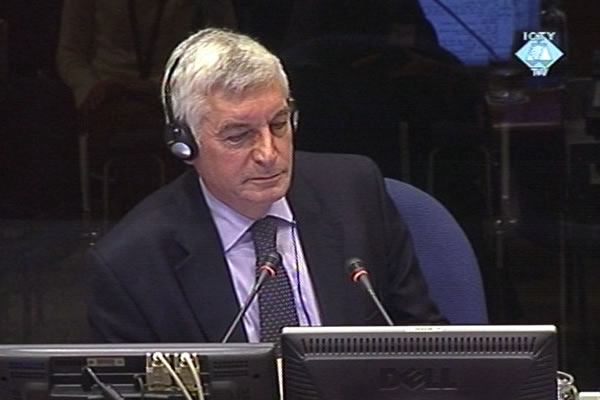Home
CIVILIANS OR SOLDIERS IN CIVILIAN CLOTHES?
The British pathologist John Clark was wrong by 44 percent when he estimated the number of soldiers exhumed from the Knin city cemetery, the defense has claimed in the cross-examination of the prosecution expert witness. Clark made his estimate on the basis of the victim’s clothes. After Clark completed his testimony, the prosecutor called another expert witness, Dutch lieutenant-colonel Harry Konings
 John Clark, svjedok na suđenju Gotovini, Čermaku i Markaču
John Clark, svjedok na suđenju Gotovini, Čermaku i Markaču As the cross-examination of British pathologist John Clark continued today, the defense counsel of Croatian general Ante Gotovina tried to prove that the four mass graves in the Knin city cemetery contained more remains of Serb soldiers than of civilians than was indicated in the witness’s expert report. The report Dr. Clark drafted at the behest of the prosecution claims that approximately one third of the 245 victims whose remains were exhumed from the cemetery ‘appeared’ to be soldiers.
Defense counsel Kehoe showed a report of the Croatian MUP from January 1996 stating that there were 102 soldiers among the victims from the Knin cemetery. According to his calculation, it is 44 percent more than what the witness had estimated. Clark couldn’t comment on the document drafted by the Croatian police because he never saw it. He added that he assumed who was soldier and who civilian based on the clothes the victims were buried in. The witness said he had never been told that some Serb soldiers changed from their uniforms to civilian clothes as they were pulling out from Krajina.
One of the victims whose remains were found in the Knin cemetery is Jovo Grubor. He and six other elderly persons were killed on 25 August 1995 in the Krajina village of Grubori, in the course of a clean-up operation in the Plavno Valley conducted by the Croatian special police. The defense of Mladen Markac, who commanded the Croatian special police at the time, argues that the elderly Serbs were ‘collateral victims’ in the clash of the police with the remaining Serb fighters; moreover, they deny that Jovo Grubor was shot first and then had his throat cut, as the prosecution alleges.
The post mortem report drafted by a team of international pathologists in Knin lead by Clark does not mention any wounds caused by a sharp object on the throat of Jovo Grubor. The cause of his death was listed as ‘at least six gunshot wounds’. Defense counsel Mikulicic showed a photo of Jovo Grubor’s body with visible injury on the throat; he asked the British expert if he thought it was a slash caused by a knife. ‘It is difficult to tell from a photograph, but I believe it’s more likely a bullet wound’, the witness replied.
When Dr. Clark completed his evidence, the prosecution called another expert, Harry Konings, a lieutenant-colonel serving in the Royal Dutch Army. He was asked by the prosecution to draft a report on ‘fire support’ of the Croatian Army during Operation Storm in August 1995. The prosecution has been trying to prove that the Croatian forces’ excessive shelling and deliberate targeting of civilian facilities throughout Krajina contributed to the exodus of the Serb population from that area. The defense argues that the Croatian artillery shelled only military targets in the course of Operation Storm.
Linked Reports
- Case : Gotovina et al. - "Operation Storm"
- 2009-01-12 FORENSIC FINDINGS FROM THE KNIN CEMETERY
- 2008-12-18 PUTTING TWO AND TWO TOGETHER
- 2008-12-17 ’VIRTUAL HANDSHAKE’ IN THE HAGUE COURTROOM
- 2009-01-14 WITNESS: 'KNIN WAS LIKE SARAJEVO'
- 2009-01-15 AMERICAN LAWS FOR GOTOVINA'S DEFENSE
- 2009-01-16 PANIC AMONG SOLDIERS OR CIVILIANS?
